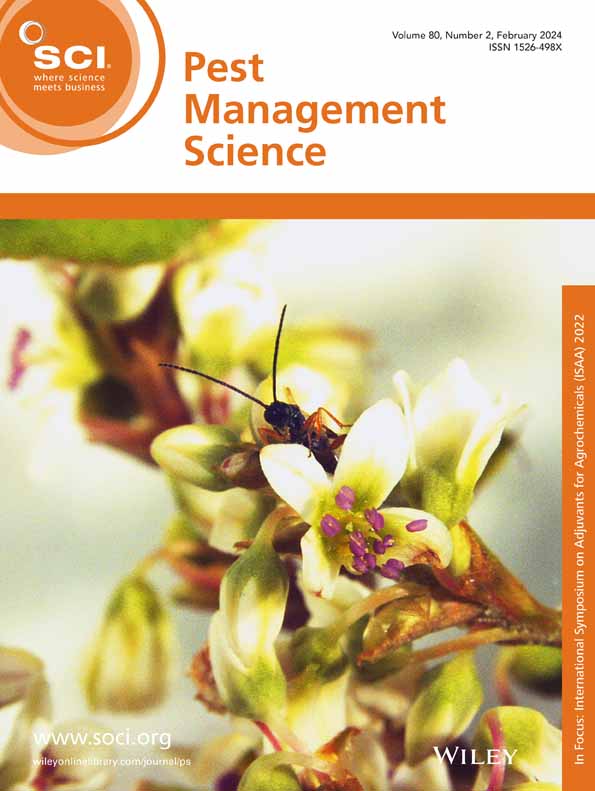Multi-omics analyses provide molecular insights into host immune responses and metabolic disruption in Spodoptera frugiperda parasitized by Pyemotes zhonghuajia.
IF 3.8
1区 农林科学
Q1 AGRONOMY
引用次数: 0
Abstract
BACKGROUND Host-parasitoid interactions are intricate biological processes in which the host's immune system mounts diverse physiological responses to counter parasitic infection. This study presents a comprehensive investigation into the molecular responses underlying the parasitism of the fall armyworm (Spodoptera frugiperda) by Pyemotes zhonghuajia, a parasitic mite with promising potential as a biocontrol agent. RESULTS Using an integrated multi-omics approach-combining lipidomics, transcriptomics, and proteomics-we examined the effects of P. zhonghuajia parasitism on S. frugiperda at sublethal (10 mites) and lethal (40 mites) densities. Lipidomic analysis revealed significant alterations across 32 lipid classes, including a marked reduction in triglycerides and membrane-associated lipids, indicating impaired energy metabolism and disrupted cellular integrity. Transcriptomic analysis identified 1287 differentially expressed genes (DEGs) under sublethal parasitism and 1774 DEGs under lethal parasitism, with key pathways involved in immune response, detoxification, and lipid metabolism. Proteomic analysis quantified over 4000 proteins, identifying 74 and 247 differentially expressed proteins (DEPs) under sublethal and lethal parasitism, respectively. Integrated analysis highlighted key immune-related proteins, such as small heat shock proteins and C-type lectins, as central to the host immune response. CONCLUSION These findings shed light on how P. zhonghuajia manipulates host immunity and metabolism, identifying potential biomarkers for pest management and contributing to the development of sustainable, RNAi-compatible biocontrol strategies. © 2025 Society of Chemical Industry.多组学分析为中华夜蛾寄生后的寄主免疫应答和代谢紊乱提供了分子机制。
宿主-拟寄生虫相互作用是一个复杂的生物过程,在这个过程中,宿主的免疫系统会产生多种生理反应来对抗寄生虫感染。摘要本研究全面研究了中华霜螨(Pyemotes zhonghuajia)对秋粘虫(Spodoptera frugiperda)寄生的分子反应。结果采用脂质组学、转录组学和蛋白质组学相结合的综合多组学方法,研究了中华家蝇寄生对亚致死密度(10螨)和致死密度(40螨)的影响。脂质组学分析揭示了32种脂类的显著变化,包括甘油三酯和膜相关脂质的显著减少,表明能量代谢受损和细胞完整性被破坏。转录组学分析鉴定出1287个亚致死寄主差异表达基因(DEGs)和1774个致死寄主差异表达基因(DEGs),其关键途径涉及免疫应答、解毒和脂质代谢。蛋白质组学分析量化了4000多个蛋白,鉴定出亚致死和致死寄生下的差异表达蛋白(DEPs)分别为74个和247个。综合分析强调了关键的免疫相关蛋白,如小热休克蛋白和c型凝集素,是宿主免疫反应的核心。结论这些发现揭示了中华家蝇调控宿主免疫和代谢的机制,为害虫防治提供了潜在的生物标志物,有助于开发可持续的、与rnai兼容的生物防治策略。©2025化学工业协会。
本文章由计算机程序翻译,如有差异,请以英文原文为准。
求助全文
约1分钟内获得全文
求助全文
来源期刊

Pest Management Science
农林科学-昆虫学
CiteScore
7.90
自引率
9.80%
发文量
553
审稿时长
4.8 months
期刊介绍:
Pest Management Science is the international journal of research and development in crop protection and pest control. Since its launch in 1970, the journal has become the premier forum for papers on the discovery, application, and impact on the environment of products and strategies designed for pest management.
Published for SCI by John Wiley & Sons Ltd.
 求助内容:
求助内容: 应助结果提醒方式:
应助结果提醒方式:


